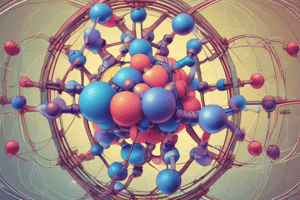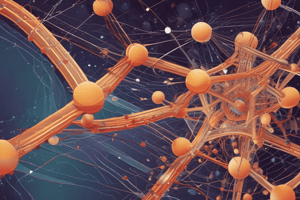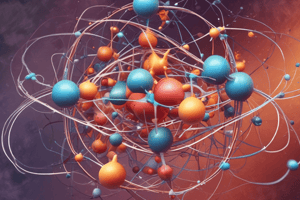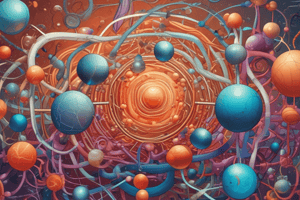Podcast
Questions and Answers
Which statement about the intermolecular forces in solids is true?
Which statement about the intermolecular forces in solids is true?
- Intermolecular forces are far less effective in solids.
- Intermolecular forces cause solids to have indefinite shape.
- Intermolecular forces hold particles in fixed positions. (correct)
- Intermolecular forces are weaker than in liquids.
What can be said about the fluidity of solids compared to liquids?
What can be said about the fluidity of solids compared to liquids?
- Solids can flow like liquids.
- Solids are non-fluid and cannot flow. (correct)
- Solids can flow under pressure.
- Solids flow easily when heated.
Which property distinguishes solids from liquids?
Which property distinguishes solids from liquids?
- Solids maintain a particular shape without a container. (correct)
- Solids can expand to fill a container.
- Solids have a definite volume but not a definite shape.
- Solids have a lower density than liquids.
According to kinetic molecular theory, which statement is true for liquids?
According to kinetic molecular theory, which statement is true for liquids?
How do the densities of solids and liquids generally compare?
How do the densities of solids and liquids generally compare?
In which state of matter do particles have complete freedom of motion and are far apart?
In which state of matter do particles have complete freedom of motion and are far apart?
What describes the arrangement of particles in a solid?
What describes the arrangement of particles in a solid?
How does a liquid behave compared to a solid?
How does a liquid behave compared to a solid?
Which statement is true regarding gases within a closed container?
Which statement is true regarding gases within a closed container?
What is characteristic of a liquid compared to a solid?
What is characteristic of a liquid compared to a solid?
Which of the following describes the kinetic energy of molecules in a solid?
Which of the following describes the kinetic energy of molecules in a solid?
When comparing the states of matter, which one has particles that are free to move but still close together?
When comparing the states of matter, which one has particles that are free to move but still close together?
What is the main concept of the Kinetic Molecular Theory (KMT)?
What is the main concept of the Kinetic Molecular Theory (KMT)?
How does temperature relate to kinetic energy according to KMT?
How does temperature relate to kinetic energy according to KMT?
In which state of matter do particles appear to move around fixed points?
In which state of matter do particles appear to move around fixed points?
What happens to molecular motion at absolute zero?
What happens to molecular motion at absolute zero?
What type of collision do particles experience according to KMT?
What type of collision do particles experience according to KMT?
Which temperature scale is primarily used in kinetic studies?
Which temperature scale is primarily used in kinetic studies?
Which statement is true regarding the movement of gas particles?
Which statement is true regarding the movement of gas particles?
When temperature decreases, what happens to particle speed?
When temperature decreases, what happens to particle speed?
Which of the following best describes a liquid's volume and shape?
Which of the following best describes a liquid's volume and shape?
What effect do collisions have on kinetic energy according to KMT?
What effect do collisions have on kinetic energy according to KMT?
Flashcards
Intermolecular Forces (IMF)
Intermolecular Forces (IMF)
The forces that hold molecules together in liquids and solids. These forces are stronger in liquids than gases.
Solid Particle Motion
Solid Particle Motion
The kinetic energy of particles in a solid is lower than in liquids and gases. This means they move less and are more densely packed.
Solid Structure
Solid Structure
Stronger IMF in solids hold particles in fixed positions, allowing only vibrations.
Fluidity in Solids
Fluidity in Solids
Signup and view all the flashcards
Density in Solids
Density in Solids
Signup and view all the flashcards
Solid
Solid
Signup and view all the flashcards
Liquid
Liquid
Signup and view all the flashcards
Gas
Gas
Signup and view all the flashcards
Kinetic Molecular Theory
Kinetic Molecular Theory
Signup and view all the flashcards
Particle Spacing
Particle Spacing
Signup and view all the flashcards
Kinetic Energy
Kinetic Energy
Signup and view all the flashcards
Particle Arrangement
Particle Arrangement
Signup and view all the flashcards
Kinetic Molecular Theory (KMT)
Kinetic Molecular Theory (KMT)
Signup and view all the flashcards
Particle Motion in KMT
Particle Motion in KMT
Signup and view all the flashcards
Elastic Collision (KMT)
Elastic Collision (KMT)
Signup and view all the flashcards
Kinetic Energy (K.E.)
Kinetic Energy (K.E.)
Signup and view all the flashcards
Temperature and Kinetic Energy
Temperature and Kinetic Energy
Signup and view all the flashcards
Kelvin (K)
Kelvin (K)
Signup and view all the flashcards
Absolute Zero
Absolute Zero
Signup and view all the flashcards
Liquid State (KMT)
Liquid State (KMT)
Signup and view all the flashcards
Study Notes
Kinetic Molecular Theory of Solids and Liquids
- Matter exists in three states: solid, liquid, and gas.
- Water is a common example, existing as ice (solid), water (liquid), and water vapor (gas).
- Solids have an ordered arrangement of particles held rigidly in place, though they can vibrate.
- Liquids flow freely and have a constant volume. Their shape conforms to the container.
- Gases have no fixed size or shape. They expand to fill their container.
What is Liquid, Solid, and Gas?
- Liquid: A substance that flows freely, has constant volume, and takes the shape of its container. Examples include water, oil, and blood.
- Solid: A firm, stable substance holding its shape, not liquid or fluid. Molecules are tightly packed and have low kinetic energy. Solids resist force due to their structural rigidity.
- Gas: A substance with no fixed size or shape. Gases expand to fill their containers. Air is an example of a gas mixture containing various pure gases.
Comparison of States (Gas, Liquid, Solid)
- Gas: Particles are widely dispersed, have complete freedom of motion, and are arranged in complete disorder. There is a lot of empty space between particles.
- Liquid: Particles are closer together than in a gas, forming clusters that can move relative to each other. Particles have less freedom of motion.
- Solid: Particles are tightly packed in fixed positions, with little freedom to move. The arrangement is highly ordered.
Kinetic Molecular Theory (KMT)
- KMT proposes that all matter is composed of particles (atoms, molecules, ions) in continuous motion.
- This motion has significant effects on matter's behavior.
- This theory was developed in the late 19th century to explain the properties of matter.
- KMT is used to describe the properties of solids, liquids, and gases in terms of particles' energy and forces between them.
Assumptions of KMT
- All matter is composed of particles.
- Particles are in continuous motion.
- The motion of particles is random.
- Particle collisions are perfectly elastic (no energy lost).
- The average kinetic energy of the particles varies with temperature.
Kinetic Energy (KE) and Temperature
- Kinetic energy is the energy of motion.
- Temperature is a measure of the average kinetic energy of particles.
- There is a direct relationship between temperature and kinetic energy; as temperature increases, kinetic energy increases.
Absolute Zero
- Absolute zero is the temperature at which all molecular motion stops (0 K or -273°C).
Kinetic Theory Description of the Liquid State
- Liquids have a definite volume but no fixed shape.
- Liquid particles are in constant motion, but are closer together than gas particles.
- Attractive forces between particles are stronger in liquids than in gases.
- These intermolecular forces prevent particles from completely separating.
Kinetic Theory Description of the Solid State
- Solids have definite volume and shape.
- Intermolecular forces are very strong in solids, leading to particles remaining in fixed positions.
- Particle motion is limited to vibrations around fixed points.
- Solids are more ordered than liquids or gases.
Properties of Liquids and Solids
- Volume/Shape: Liquids have definite volume but indefinite shape; solids have definite volume and shape.
- Fluidity: Liquids flow, solids do not.
- Density: Liquids and solids typically have higher densities compared to gases.
- Compressibility: Liquids and solids are generally less compressible (difficult to compress).
- Diffusibility: Solids and liquids diffuse slowly compared to gases.
- Motion of Molecules: Liquid particles have random motion, medium speeds, and limited movement distances; solid particles vibrate in place.
Examples of Liquids and Solids
- Provided examples are listed in the images. (Oil, Water, Blood, etc.)
Studying That Suits You
Use AI to generate personalized quizzes and flashcards to suit your learning preferences.




